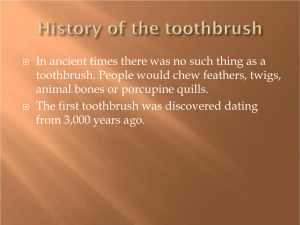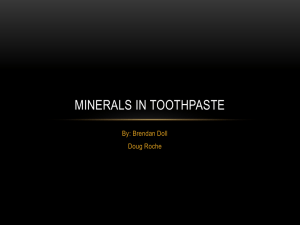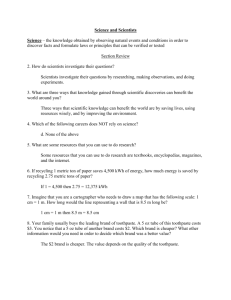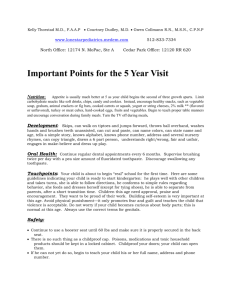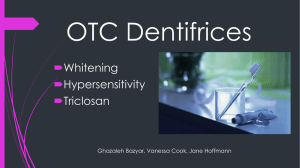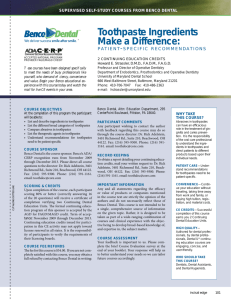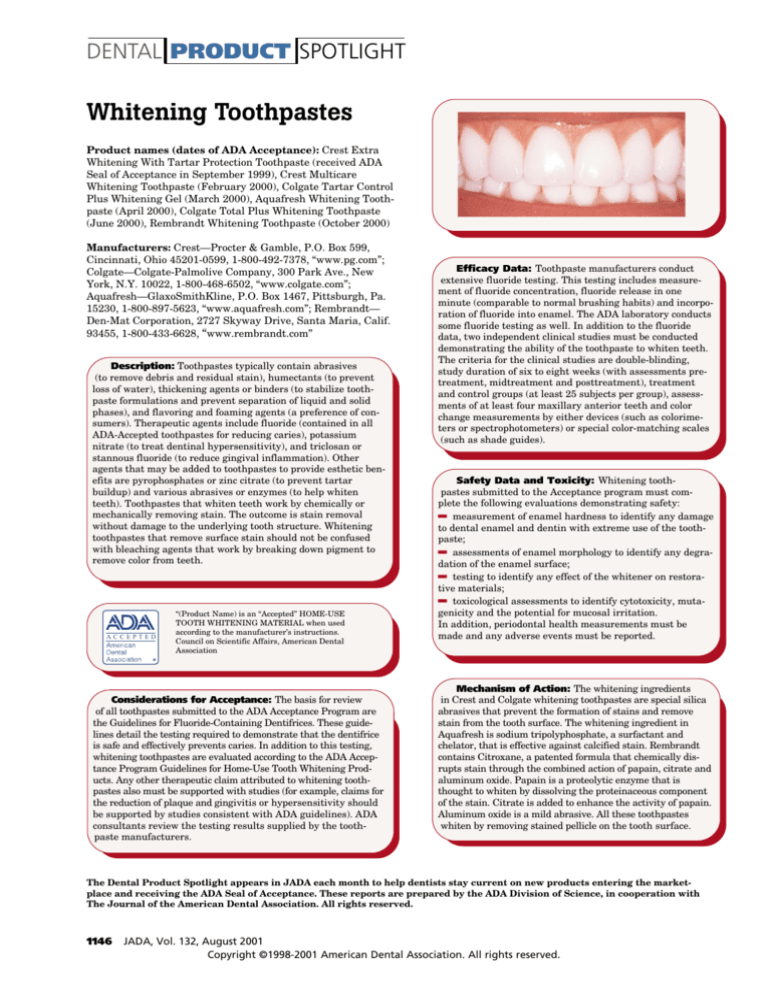
DENTAL PRODUCT SPOTLIGHT
Whitening Toothpastes
Product names (dates of ADA Acceptance): Crest Extra
Whitening With Tartar Protection Toothpaste (received ADA
Seal of Acceptance in September 1999), Crest Multicare
Whitening Toothpaste (February 2000), Colgate Tartar Control
Plus Whitening Gel (March 2000), Aquafresh Whitening Toothpaste (April 2000), Colgate Total Plus Whitening Toothpaste
(June 2000), Rembrandt Whitening Toothpaste (October 2000)
Manufacturers: Crest—Procter & Gamble, P.O. Box 599,
Cincinnati, Ohio 45201-0599, 1-800-492-7378, “www.pg.com”;
Colgate—Colgate-Palmolive Company, 300 Park Ave., New
York, N.Y. 10022, 1-800-468-6502, “www.colgate.com”;
Aquafresh—GlaxoSmithKline, P.O. Box 1467, Pittsburgh, Pa.
15230, 1-800-897-5623, “www.aquafresh.com”; Rembrandt—
Den-Mat Corporation, 2727 Skyway Drive, Santa Maria, Calif.
93455, 1-800-433-6628, “www.rembrandt.com”
Description: Toothpastes typically contain abrasives
(to remove debris and residual stain), humectants (to prevent
loss of water), thickening agents or binders (to stabilize toothpaste formulations and prevent separation of liquid and solid
phases), and flavoring and foaming agents (a preference of consumers). Therapeutic agents include fluoride (contained in all
ADA-Accepted toothpastes for reducing caries), potassium
nitrate (to treat dentinal hypersensitivity), and triclosan or
stannous fluoride (to reduce gingival inflammation). Other
agents that may be added to toothpastes to provide esthetic benefits are pyrophosphates or zinc citrate (to prevent tartar
buildup) and various abrasives or enzymes (to help whiten
teeth). Toothpastes that whiten teeth work by chemically or
mechanically removing stain. The outcome is stain removal
without damage to the underlying tooth structure. Whitening
toothpastes that remove surface stain should not be confused
with bleaching agents that work by breaking down pigment to
remove color from teeth.
ACCEPTED
“(Product Name) is an “Accepted” HOME-USE
TOOTH WHITENING MATERIAL when used
according to the manufacturer’s instructions.
Council on Scientific Affairs, American Dental
Association
Considerations for Acceptance: The basis for review
of all toothpastes submitted to the ADA Acceptance Program are
the Guidelines for Fluoride-Containing Dentifrices. These guidelines detail the testing required to demonstrate that the dentifrice
is safe and effectively prevents caries. In addition to this testing,
whitening toothpastes are evaluated according to the ADA Acceptance Program Guidelines for Home-Use Tooth Whitening Products. Any other therapeutic claim attributed to whitening toothpastes also must be supported with studies (for example, claims for
the reduction of plaque and gingivitis or hypersensitivity should
be supported by studies consistent with ADA guidelines). ADA
consultants review the testing results supplied by the toothpaste manufacturers.
Efficacy Data: Toothpaste manufacturers conduct
extensive fluoride testing. This testing includes measurement of fluoride concentration, fluoride release in one
minute (comparable to normal brushing habits) and incorporation of fluoride into enamel. The ADA laboratory conducts
some fluoride testing as well. In addition to the fluoride
data, two independent clinical studies must be conducted
demonstrating the ability of the toothpaste to whiten teeth.
The criteria for the clinical studies are double-blinding,
study duration of six to eight weeks (with assessments pretreatment, midtreatment and posttreatment), treatment
and control groups (at least 25 subjects per group), assessments of at least four maxillary anterior teeth and color
change measurements by either devices (such as colorimeters or spectrophotometers) or special color-matching scales
(such as shade guides).
Safety Data and Toxicity: Whitening toothpastes submitted to the Acceptance program must complete the following evaluations demonstrating safety:
d measurement of enamel hardness to identify any damage
to dental enamel and dentin with extreme use of the toothpaste;
d assessments of enamel morphology to identify any degradation of the enamel surface;
d testing to identify any effect of the whitener on restorative materials;
d toxicological assessments to identify cytotoxicity, mutagenicity and the potential for mucosal irritation.
In addition, periodontal health measurements must be
made and any adverse events must be reported.
Mechanism of Action: The whitening ingredients
in Crest and Colgate whitening toothpastes are special silica
abrasives that prevent the formation of stains and remove
stain from the tooth surface. The whitening ingredient in
Aquafresh is sodium tripolyphosphate, a surfactant and
chelator, that is effective against calcified stain. Rembrandt
contains Citroxane, a patented formula that chemically disrupts stain through the combined action of papain, citrate and
aluminum oxide. Papain is a proteolytic enzyme that is
thought to whiten by dissolving the proteinaceous component
of the stain. Citrate is added to enhance the activity of papain.
Aluminum oxide is a mild abrasive. All these toothpastes
whiten by removing stained pellicle on the tooth surface.
The Dental Product Spotlight appears in JADA each month to help dentists stay current on new products entering the marketplace and receiving the ADA Seal of Acceptance. These reports are prepared by the ADA Division of Science, in cooperation with
The Journal of the American Dental Association. All rights reserved.
1146
JADA, Vol. 132, August 2001
Copyright ©1998-2001 American Dental Association. All rights reserved.
DENTAL P R O D U C T
SPOTLIGHT
Toothpaste formulation
racticing good oral hygiene results in
the reduction of plaque, caries and gingivitis. Toothpastes improve oral
hygiene by enhancing the effect of
mechanical scrubbing with a toothbrush
and by delivering therapeutic agents to the oral
cavity. The composition of toothpastes can be
modified depending on the targeted therapy; however, the main therapeutic effect is a reduction of
caries that occurs through assimilation of fluoride
ions into the apatite crystal of enamel. Fluoride in
toothpaste is in the form of sodium fluoride, stannous fluoride or sodium monofluorophosphate. In
addition to their anticaries effect, most toothpastes can be broadly classified as having antitartar, cosmetic, antigingivitis, antiplaque or antihypersensitivity effects, or some combination of
these effects.
P
THE COMPONENTS OF TOOTHPASTE
Abrasives. Abrasives are added to toothpaste to
remove stained pellicle from dentition. Abrasives
work in concert with the toothbrush and have no
effect on their own. The removal of plaque also is
associated minimally with abrasives, which is
another action attributed to the toothbrush. Calcium carbonate, dicalcium phosphates, hydrated
alumina and various silica compounds are used as
abrasives in toothpaste. The factors that affect the
cleaning agent’s abrasivity are hydration, particle
size and shape, source, purity, and physical or
chemical treatment. Ideally, abrasives should be
nearly inert chemically. Toothpastes are tested to
determine whether the abrasive component is satisfactory for removal of stain, while not damaging
to the tooth structure.
Detergents. Detergents also are added to
toothpastes for cleaning. Detergents act by lowering surface tension to solubilize substances,
allowing penetration and loosening of surface
deposits. The foaming action of toothpastes
results from the addition of detergents. It is
important that the detergent added to a toothpaste is mild so that it does not irritate the oral
mucosa. The most commonly used detergent is
sodium lauryl sulfate. There have been reports of
sodium lauryl sulfate’s causing increased oral irri-
tation in people who have recurring aphthous
ulcers. For such people, manufacturers make
toothpastes that do not contain sodium lauryl
sulfate.
Humectant systems. Humectants and
binding agents are important ingredients for
maintaining the consistency of toothpaste. They
are combined with preservatives to form complex mixtures referred to as humectant systems, which fulfill three purposes:
d providing a vehicle to which the other ingredients can be incorporated;
d keeping moisture in the toothpaste;
d preventing the growth of microorganisms.
The humectants commonly used are polyols
(that is, glycerin, sorbitol and hydrogenated
starch hydrolyzates). The preservative usually
added is sodium benzoate. Binding agents are
hydrophilic colloids that prevent separation of
the toothpaste components by maintaining the
liquid and solid components in one phase. A
naturally occurring binding agent is gum
arabic; synthetic ones include sodium carboxymethylcellulose and magnesium aluminum
silicate.
Flavoring agents. Either natural flavoring
agents (such as spearmint, peppermint, wintergreen, cinnamon, anise and fruit extracts) or
artificial flavoring agents are added to toothpaste. ADA-Accepted toothpastes do not contain
sugar, but some do contain artificial sweeteners
(such as saccharin). The humectants glycerin
and sorbitol also give toothpaste a sweet taste.
FORMULATION: AN IMPORTANT
CONSIDERATION
The combination of ingredients selected for a
toothpaste depends on the desired qualities of
the toothpaste and on the ingredients’ compatibility. A toothpaste’s formulation is an important consideration, because some ingredients
can interfere with the effectiveness of others.
For example, some cleaning agents have been
shown to interfere with the availability of some
therapeutic agents. The purity and chemical
nature of the toothpaste ingredients, therefore,
have become an important consideration. ■
JADA, Vol. 132, August 2001
Copyright ©1998-2001 American Dental Association. All rights reserved.
1147


